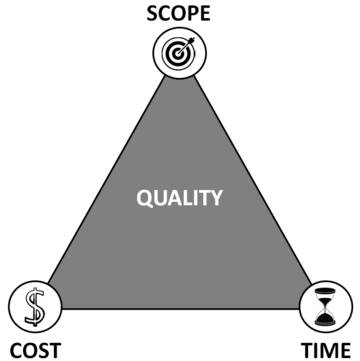Iron Triangle of Project Management
(→Big idea) |
|||
| Line 3: | Line 3: | ||
== Big idea == | == Big idea == | ||
| − | |||
[[File:Pmtriangle.png|thumb|upright=2.0|alt=Illustration of the iron triangle of project management.|'''Figure 1: '''The iron triangle of project management, illustrating the interrelation of scope, time, and cost. Modified from ''Fundamentals of Project Management'' by Heagney <ref name="PMfundamentals">Heagney, J. (2011). Fundamentals of Project Management (4th ed.). AMACOM.</ref>]] | [[File:Pmtriangle.png|thumb|upright=2.0|alt=Illustration of the iron triangle of project management.|'''Figure 1: '''The iron triangle of project management, illustrating the interrelation of scope, time, and cost. Modified from ''Fundamentals of Project Management'' by Heagney <ref name="PMfundamentals">Heagney, J. (2011). Fundamentals of Project Management (4th ed.). AMACOM.</ref>]] | ||
| + | Portfolio, program, and project management all operate in parallel and provide a structured way to align and effectively carry out organizational strategies. However, there is a difference in their focus and contribution to the attainment of strategic objectives and the theory regarding the iron triangle is primarily associated with project management. <ref name="programstandard">The Standard for Program Management (Fourth edition). (2017). Project Management Institute.</ref> | ||
| + | |||
Project management is the application of knowledge, skills, tools, and techniques to meet a projects’ requirements. Effective project management consequently helps organizations to increase chances of success and meet business objectives. Poorly managed projects, on the other hand, may result in missed deadlines, cost overruns, and poor quality projects. <ref name="pmbasic" /> | Project management is the application of knowledge, skills, tools, and techniques to meet a projects’ requirements. Effective project management consequently helps organizations to increase chances of success and meet business objectives. Poorly managed projects, on the other hand, may result in missed deadlines, cost overruns, and poor quality projects. <ref name="pmbasic" /> | ||
Revision as of 19:59, 16 February 2021
Contents |
Abstract
The roles of a project manager are numerous and one important role in attaining project success by balancing the competing constraints on a project with the resources available [1]. Without constraints, that would be a simple task and all projects would be good, fast, and cheap. Unfortunately, that is not the case as most projects must operate within some important boundaries concerning, scope, time, and cost. The interrelation of these components can make the difference between project success and failure and maintaining a balance between the three factors is therefore essential. The iron triangle is a model of these project elements and emphasizes that a change in one factor invariably affects the others. The theory helps project managers better understand the trade-off among these main constraints of project management. Even though the constraints of the iron triangle are a decent indicator regarding project management success, it is not necessarily the only marker of overall project success. The project scope can be delivered on time and within budget but ultimately result in an unsuccessful project because there are various other factors that help determine the effectiveness of a project. This article will describe the essence of the iron triangle, how project managers can apply the concept in practice, and the main limitations of the theory.
Big idea

Portfolio, program, and project management all operate in parallel and provide a structured way to align and effectively carry out organizational strategies. However, there is a difference in their focus and contribution to the attainment of strategic objectives and the theory regarding the iron triangle is primarily associated with project management. [3]
Project management is the application of knowledge, skills, tools, and techniques to meet a projects’ requirements. Effective project management consequently helps organizations to increase chances of success and meet business objectives. Poorly managed projects, on the other hand, may result in missed deadlines, cost overruns, and poor quality projects. [1]
The iron triangle (also called the project management triangle) is a concept based on the triple constraints of project management and an important theory in the field. These constraints are limitations placed upon a project which the project manager and team must operate within. There can be various constraints on a project, but there are three essential constraints that operate on every project. These constraints are time, scope, and cost. [4]
Application
Limitations
Annotated bibliography
[?] https://strategyzer.com TEXT
[?] BOOK TITLE TEXT
References
- ↑ 1.0 1.1 P.M.I. (2017). A Guide to the Project Management Body of Knowledge (6th ed.). Project Management Institute.
- ↑ Heagney, J. (2011). Fundamentals of Project Management (4th ed.). AMACOM.
- ↑ The Standard for Program Management (Fourth edition). (2017). Project Management Institute.
- ↑ Everitt, J. (2020, May 25). Understanding The Project Management Triangle. Wrike. https://www.wrike.com/blog/understanding-project-management-triangle/